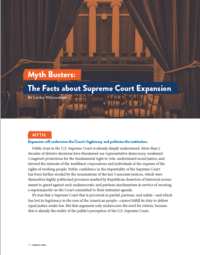MYTH: The Court may be a threat now, but it has been an important defender of the rights of Black and brown people in the past. Delegitimizing this important backstop of the rights of vulnerable people is dangerous.
While the period of the Warren Court was an important moment for the Court in championing civil rights and justice, it was just that—a moment. Outside that era and a few important decisions like Brown, the U.S. Supreme Court has by and large been a regressive institution that has threatened or all-out attacked the rights of Black and brown people and other social and political minorities.
In its infamous Dred Scott decision (1857), the Court banned Congress from restricting the spread of slavery and from giving Black people the rights of citizenship. In addition to helping to spark the Civil War, the Court’s regressiveness on race restricted the promise of Reconstruction. In Cruickshank (1876) and related cases over the subsequent decades, the Court said Congress had no power to punish lynch mobs or protect voting rights from state disenfranchisement. In a series of cases decided in 1883 (the Civil Rights Cases), it restricted Congress from passing anti-discrimination laws, considerably weakening the Reconstruction Amendments. In Plessy (1896), among the most infamous decisions in Supreme Court history, the Court found it “natural” for a state to enforce segregation based on race, ushering in more than a half-century of state-sanctioned apartheid in the South. In the early 20th century, it prevented Congress from banning child labor (Hammer, 1918, and Child Labor Tax Case, 1922). During the Great Depression, a series of decisions (Schechter Poultry v. United States, 1935, among others) initially overturned key New Deal policies aimed at worker protection and economic recovery. In 1976, with Buckley, and again in 2010 with Citizens United and 2013 with McCutcheon, the Court eviscerated attempts to regulate campaign finance and created a right for wealthy, corporate interests to drown out the voices of everyday people in our elections. In 1995, its decision in Adarand cramped the federal government’s ability to enact race-conscious remedies for racial discrimination. In NFIB, the landmark Affordable Care Act (ACA) decision in 2012, it undermined the ACA, depriving millions of low-income Americans, including many Black and brown people, of the chance to have health insurance through Medicaid expansion. In Shelby (2013) and most recently in Brnovich (2021), the Court first struck down and then severely weakened Congress’s protections against racial discrimination in voting, leaving millions of Black and brown voters subject to racist voter suppression. And in Whole Women’s Health (2021), the Court allowed a radical abortion ban to go into effect in Texas, preventing most abortion-seekers in the state—including many Black and brown Texans—from accessing the reproductive care they need.
In these recent cases, a bare majority of the Court—which is to say, a tiny handful of unaccountable, unelected justices—are overriding the democratic decisions of the Congress and the president. And they are doing so in favor of a radical ideological vision aligned with the fringes of the American political spectrum, and against the interests of the masses.
Far from a bulwark for the rights of Black and brown people or other communities subject to discrimination, the Supreme Court has throughout history posed much more of a threat, and done significantly more damage, to the rights and well-being of these communities. As Harvard law professor Nikolas Bowie put it in his recent testimony to the Presidential Commission on the Supreme Court, “if you look at the history of the judicial review of federal legislation, the principal ‘minority’ most often protected by the Court is the wealthy.”


